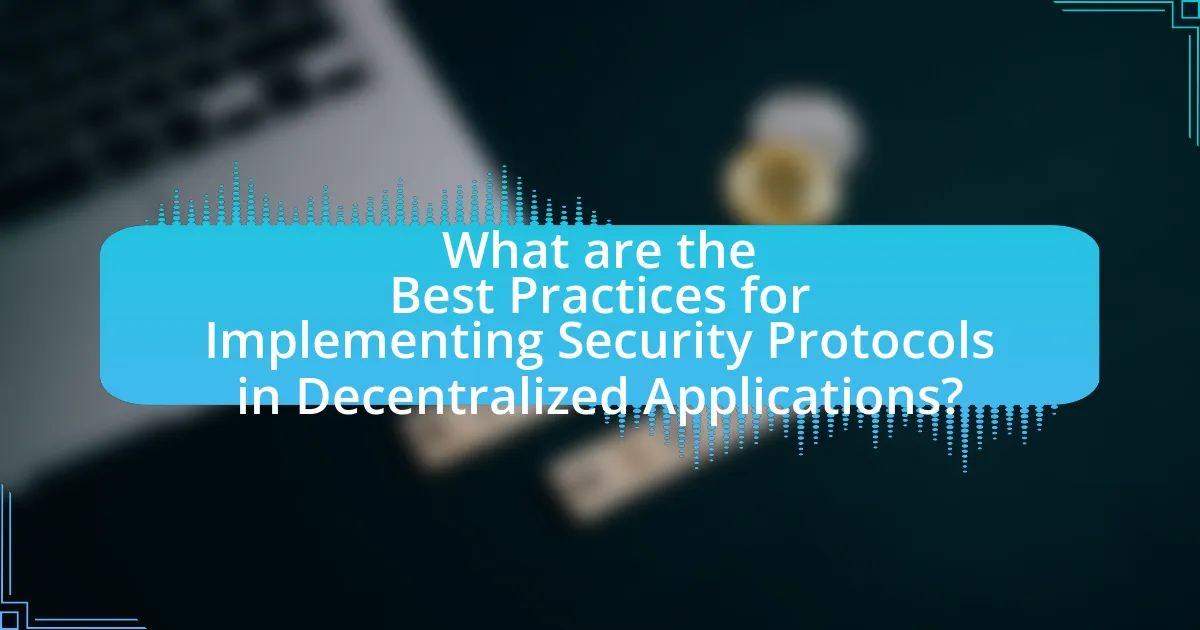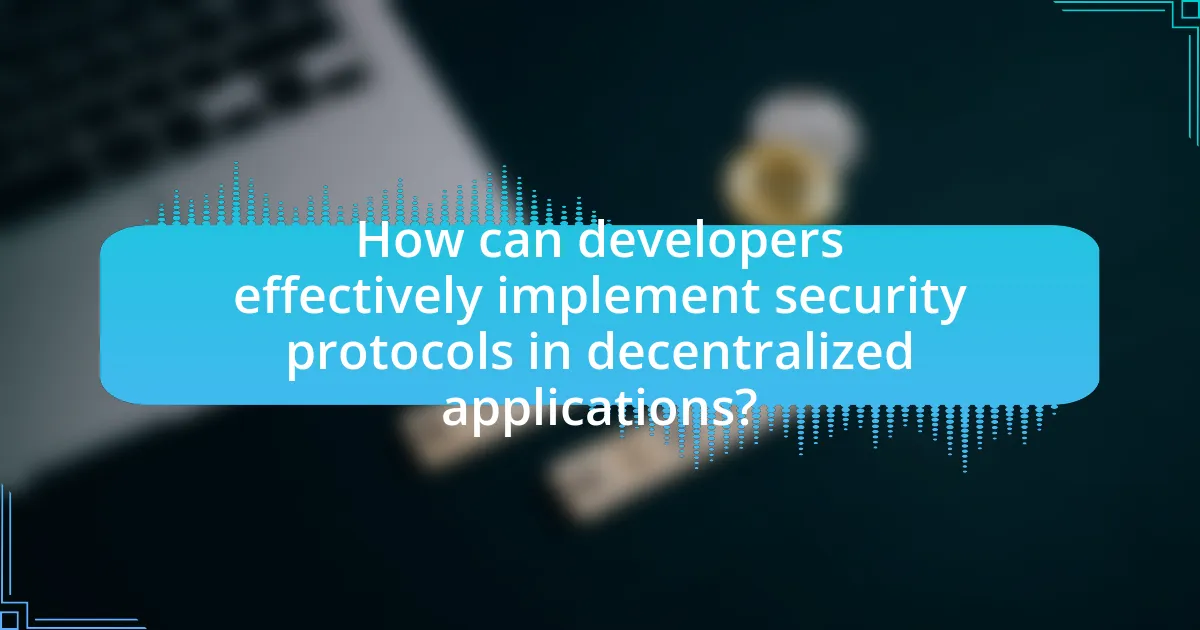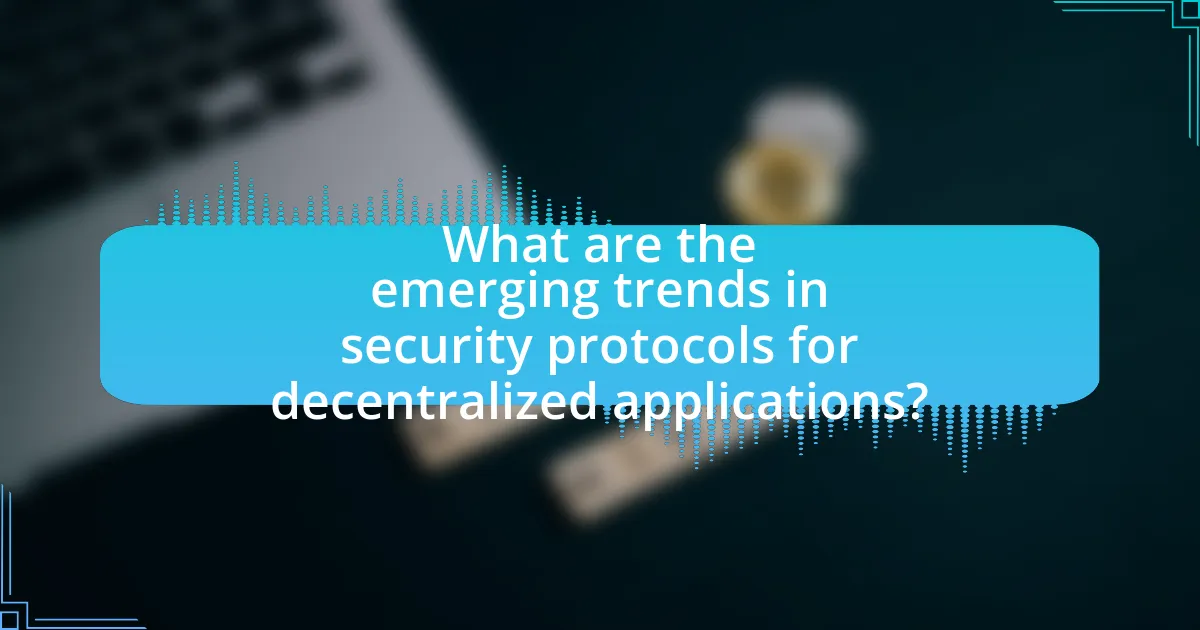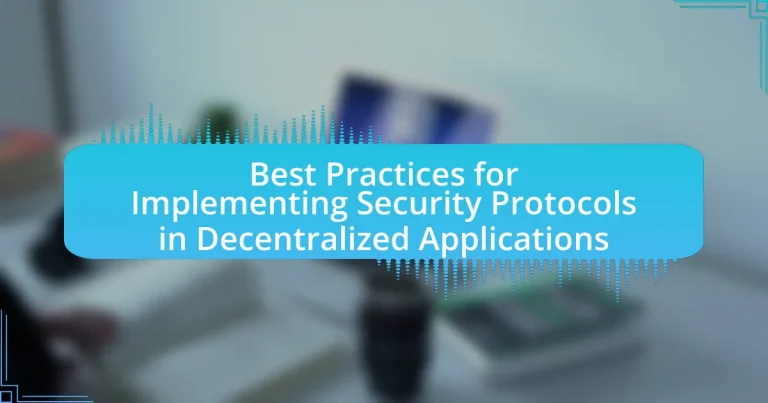The article focuses on best practices for implementing security protocols in decentralized applications (dApps). It emphasizes the importance of strong cryptographic techniques, regular security audits, and robust access controls to protect user data and assets from unauthorized access and malicious attacks. The article outlines unique security challenges faced by dApps, such as vulnerabilities in smart contracts and decentralized governance risks, while contrasting their security features with traditional applications. Key components of security protocols, including consensus mechanisms and common security protocols like TLS and HTTPS, are discussed, along with the role of emerging technologies like artificial intelligence and decentralized identity solutions in enhancing security. Additionally, it addresses future challenges, including the implications of quantum computing and evolving regulatory landscapes on security practices.

What are the Best Practices for Implementing Security Protocols in Decentralized Applications?
The best practices for implementing security protocols in decentralized applications include utilizing strong cryptographic techniques, conducting regular security audits, and ensuring robust access controls. Strong cryptographic techniques, such as end-to-end encryption and secure key management, protect data integrity and confidentiality. Regular security audits identify vulnerabilities and ensure compliance with security standards, while robust access controls limit user permissions and reduce the risk of unauthorized access. These practices are essential for safeguarding decentralized applications against potential threats and ensuring user trust.
Why is security crucial in decentralized applications?
Security is crucial in decentralized applications because it protects user data and assets from unauthorized access and malicious attacks. In decentralized systems, where control is distributed among multiple nodes, vulnerabilities can lead to significant risks, including data breaches and financial losses. For instance, the DAO hack in 2016 resulted in the loss of $60 million worth of Ether due to security flaws, highlighting the importance of robust security measures. Ensuring security in decentralized applications fosters user trust and promotes wider adoption, as users are more likely to engage with platforms that prioritize their safety.
What unique security challenges do decentralized applications face?
Decentralized applications face unique security challenges primarily due to their reliance on distributed networks and smart contracts. These challenges include vulnerabilities in smart contract code, which can be exploited by attackers; lack of centralized control, making it difficult to implement consistent security measures; and exposure to decentralized governance risks, where malicious actors can influence decision-making processes. For instance, the DAO hack in 2016, which resulted in a loss of $60 million, highlighted the risks associated with poorly audited smart contracts. Additionally, decentralized applications often face issues related to user privacy and data integrity, as the transparency of blockchain can expose sensitive information.
How do decentralized applications differ from traditional applications in terms of security?
Decentralized applications (dApps) differ from traditional applications in terms of security primarily due to their reliance on blockchain technology, which enhances data integrity and reduces single points of failure. In dApps, data is distributed across a network of nodes, making it more resilient to attacks such as data tampering and server outages, whereas traditional applications typically store data in centralized servers, which are more vulnerable to breaches. For instance, a study by the European Union Agency for Cybersecurity highlights that decentralized systems can mitigate risks associated with centralized data storage, as they do not have a single target for attackers. This structural difference fundamentally alters the security landscape, making dApps generally more secure against certain types of cyber threats.
What are the key components of security protocols in decentralized applications?
The key components of security protocols in decentralized applications include cryptographic techniques, consensus mechanisms, access control, and data integrity measures. Cryptographic techniques, such as public-key cryptography, ensure secure communication and authentication between users. Consensus mechanisms, like Proof of Work or Proof of Stake, validate transactions and maintain network integrity without a central authority. Access control mechanisms regulate user permissions and ensure that only authorized entities can perform specific actions. Data integrity measures, including hashing and digital signatures, protect against unauthorized data alterations, ensuring that the information remains accurate and trustworthy. These components collectively enhance the security posture of decentralized applications, making them resilient against various threats.
What role do cryptographic techniques play in securing decentralized applications?
Cryptographic techniques are essential for securing decentralized applications by ensuring data integrity, confidentiality, and authentication. These techniques, such as hashing, encryption, and digital signatures, protect user data from unauthorized access and tampering. For instance, hashing algorithms like SHA-256 are used to create unique identifiers for transactions, making it nearly impossible to alter them without detection. Additionally, encryption methods safeguard sensitive information during transmission, while digital signatures verify the authenticity of transactions, ensuring that they originate from legitimate sources. The implementation of these cryptographic methods is critical in maintaining trust and security within decentralized networks, as evidenced by their foundational role in blockchain technology, which relies on cryptography to secure its decentralized ledger.
How can consensus mechanisms enhance security in decentralized applications?
Consensus mechanisms enhance security in decentralized applications by ensuring that all participants agree on the validity of transactions before they are added to the blockchain. This agreement process mitigates the risk of double-spending and prevents malicious actors from altering transaction history. For instance, in Proof of Work systems, miners must solve complex mathematical problems, which requires significant computational resources, making it economically unfeasible for an attacker to manipulate the network. Additionally, in Proof of Stake systems, validators are incentivized to act honestly because they risk losing their staked assets if they attempt to defraud the network. These mechanisms create a robust framework that secures the integrity of decentralized applications by aligning the interests of participants with the overall security of the system.
What are the common security protocols used in decentralized applications?
Common security protocols used in decentralized applications include Transport Layer Security (TLS), Secure Hypertext Transfer Protocol (HTTPS), and Public Key Infrastructure (PKI). TLS ensures encrypted communication over a computer network, protecting data integrity and privacy during transmission. HTTPS, which utilizes TLS, secures web communications, making it essential for decentralized applications that interact with users via web interfaces. PKI supports secure data exchange by managing digital certificates and public-private key pairs, enabling authentication and encryption. These protocols are foundational in safeguarding decentralized applications against various security threats, including data breaches and unauthorized access.
How does the use of blockchain technology contribute to security?
Blockchain technology enhances security through its decentralized and immutable nature. Each transaction is recorded in a block and linked to the previous block, creating a secure chain that is resistant to tampering. This structure ensures that once data is added to the blockchain, it cannot be altered without consensus from the network, making unauthorized changes nearly impossible. Additionally, cryptographic techniques used in blockchain, such as hashing and digital signatures, provide further layers of security by ensuring data integrity and authenticity. According to a study by the World Economic Forum, blockchain can reduce fraud and increase trust in digital transactions, highlighting its effectiveness in enhancing security protocols in decentralized applications.
What are the advantages of using smart contracts for security?
Smart contracts enhance security by automating and enforcing agreements without the need for intermediaries. This automation reduces the risk of human error and fraud, as the contract executes predefined conditions transparently on a blockchain. Additionally, smart contracts are immutable, meaning once deployed, they cannot be altered, which protects against tampering. The use of cryptographic techniques ensures that transactions are secure and verifiable, further safeguarding the integrity of the data involved. According to a report by the World Economic Forum, smart contracts can significantly lower transaction costs and increase trust among parties, making them a valuable tool for enhancing security in decentralized applications.

How can developers effectively implement security protocols in decentralized applications?
Developers can effectively implement security protocols in decentralized applications by utilizing cryptographic techniques, conducting thorough code audits, and employing decentralized identity solutions. Cryptographic techniques, such as public-private key pairs and hashing algorithms, ensure data integrity and confidentiality, which are essential in a decentralized environment. Thorough code audits help identify vulnerabilities and ensure compliance with security standards, as evidenced by the increased security of applications that undergo regular assessments. Decentralized identity solutions, like self-sovereign identities, enhance user privacy and control over personal data, reducing the risk of data breaches. These practices collectively strengthen the security posture of decentralized applications.
What steps should developers take to ensure security during the development process?
Developers should implement secure coding practices, conduct regular security assessments, and utilize automated security tools during the development process. Secure coding practices involve following established guidelines such as the OWASP Top Ten, which helps mitigate common vulnerabilities. Regular security assessments, including code reviews and penetration testing, identify potential weaknesses before deployment. Automated security tools, such as static application security testing (SAST) and dynamic application security testing (DAST), streamline the detection of vulnerabilities throughout the development lifecycle. These steps collectively enhance the security posture of decentralized applications, ensuring that potential threats are addressed proactively.
How can threat modeling be utilized in the development of decentralized applications?
Threat modeling can be utilized in the development of decentralized applications by systematically identifying, assessing, and prioritizing potential security threats throughout the application lifecycle. This process enables developers to understand the unique vulnerabilities associated with decentralized architectures, such as smart contracts and peer-to-peer networks, and to implement appropriate security measures early in the design phase. For instance, threat modeling frameworks like STRIDE or PASTA can help teams analyze threats related to data integrity, confidentiality, and availability specific to decentralized systems. By employing these frameworks, developers can create a more resilient application, as evidenced by studies showing that proactive threat modeling reduces the likelihood of security breaches by up to 50%.
What testing methodologies are effective for identifying security vulnerabilities?
Effective testing methodologies for identifying security vulnerabilities include static application security testing (SAST), dynamic application security testing (DAST), and penetration testing. SAST analyzes source code for vulnerabilities without executing the program, allowing early detection of security flaws during development. DAST tests the running application to identify vulnerabilities that can be exploited in real-time, providing insights into runtime security issues. Penetration testing simulates real-world attacks to evaluate the security posture of an application, revealing potential weaknesses that could be exploited by attackers. These methodologies are widely recognized in the cybersecurity community for their effectiveness in uncovering security vulnerabilities, as evidenced by industry standards and frameworks such as OWASP (Open Web Application Security Project), which emphasizes the importance of these testing approaches in securing applications.
What best practices should be followed post-deployment for maintaining security?
Post-deployment, best practices for maintaining security include regular security audits, timely software updates, and continuous monitoring of system activities. Regular security audits help identify vulnerabilities and ensure compliance with security policies, while timely software updates patch known vulnerabilities, reducing the risk of exploitation. Continuous monitoring of system activities allows for the detection of unusual behavior, enabling prompt response to potential threats. According to a report by the Ponemon Institute, organizations that conduct regular security audits reduce the likelihood of a data breach by 50%.
How can regular audits and updates improve the security of decentralized applications?
Regular audits and updates enhance the security of decentralized applications by identifying vulnerabilities and ensuring that the software remains resilient against emerging threats. Audits systematically evaluate the code and architecture of decentralized applications, revealing weaknesses that could be exploited by attackers. For instance, a study by the Blockchain Security Alliance found that 70% of smart contract vulnerabilities could be detected through thorough code audits. Updates, on the other hand, address these vulnerabilities and incorporate the latest security patches, thereby fortifying the application against known exploits. The combination of regular audits and timely updates creates a proactive security posture, significantly reducing the risk of breaches and ensuring the integrity of decentralized applications.
What role does user education play in maintaining security in decentralized applications?
User education is crucial for maintaining security in decentralized applications as it empowers users to recognize and mitigate potential threats. Educated users are more likely to understand the importance of secure practices, such as safeguarding private keys and recognizing phishing attempts. Research indicates that human error is a significant factor in security breaches; for instance, a study by the Ponemon Institute found that 95% of cybersecurity incidents involve human error. Therefore, effective user education can significantly reduce vulnerabilities and enhance the overall security posture of decentralized applications.

What are the emerging trends in security protocols for decentralized applications?
Emerging trends in security protocols for decentralized applications include the adoption of zero-knowledge proofs, decentralized identity solutions, and enhanced cryptographic techniques. Zero-knowledge proofs allow one party to prove to another that a statement is true without revealing any information beyond the validity of the statement itself, enhancing privacy and security. Decentralized identity solutions, such as self-sovereign identity frameworks, empower users to control their personal data, reducing reliance on centralized authorities and minimizing data breaches. Enhanced cryptographic techniques, including post-quantum cryptography, are being developed to protect against future threats posed by quantum computing, ensuring long-term security for decentralized applications. These trends reflect a growing emphasis on privacy, user control, and resilience against emerging threats in the decentralized ecosystem.
How is artificial intelligence influencing security in decentralized applications?
Artificial intelligence is enhancing security in decentralized applications by enabling advanced threat detection and response mechanisms. AI algorithms analyze vast amounts of data in real-time, identifying anomalies and potential security breaches more efficiently than traditional methods. For instance, machine learning models can learn from historical attack patterns, allowing them to predict and mitigate future threats. According to a report by the World Economic Forum, AI-driven security solutions can reduce incident response times by up to 90%, significantly improving the overall security posture of decentralized systems.
What potential does machine learning have in detecting security threats?
Machine learning has significant potential in detecting security threats by analyzing vast amounts of data to identify patterns indicative of malicious activity. This capability allows for real-time threat detection, enabling systems to respond swiftly to potential breaches. For instance, machine learning algorithms can process network traffic data to recognize anomalies that deviate from established baselines, which is crucial in identifying intrusions or attacks. Research has shown that machine learning models can achieve over 90% accuracy in detecting phishing attempts and malware, demonstrating their effectiveness in enhancing cybersecurity measures.
How can decentralized identity solutions enhance security protocols?
Decentralized identity solutions enhance security protocols by enabling users to control their own identity data, reducing the risk of centralized data breaches. By utilizing blockchain technology, these solutions ensure that identity verification processes are tamper-proof and transparent, which significantly mitigates identity theft and fraud. For instance, a study by the World Economic Forum highlights that decentralized identity systems can lower the costs associated with identity verification by up to 50%, while also improving user privacy and security. This shift from centralized to decentralized identity management creates a more resilient security framework, as it eliminates single points of failure and enhances user trust in digital interactions.
What future challenges might arise in securing decentralized applications?
Future challenges in securing decentralized applications include vulnerabilities in smart contracts, scalability issues, and regulatory compliance. Smart contracts, which automate processes, can contain coding errors that lead to exploits; for instance, the DAO hack in 2016 resulted in a loss of $60 million due to a vulnerability. Scalability challenges arise as decentralized networks grow, potentially leading to slower transaction speeds and increased costs, which can deter user adoption. Additionally, as governments develop regulations for blockchain technology, decentralized applications may face compliance hurdles that could limit their functionality or require significant modifications to meet legal standards.
How can evolving regulatory landscapes impact security practices?
Evolving regulatory landscapes can significantly impact security practices by necessitating compliance with new legal requirements and standards. As regulations such as the General Data Protection Regulation (GDPR) and the California Consumer Privacy Act (CCPA) emerge, organizations must adapt their security protocols to ensure they meet these obligations. For instance, GDPR mandates strict data protection measures, compelling companies to implement robust encryption and access controls to safeguard personal data. Failure to comply can result in substantial fines, which underscores the importance of aligning security practices with regulatory expectations. Thus, the dynamic nature of regulations drives organizations to continuously update and enhance their security frameworks to mitigate legal risks and protect sensitive information.
What are the implications of quantum computing for decentralized application security?
Quantum computing poses significant implications for decentralized application security by potentially breaking traditional cryptographic algorithms used to secure these applications. Current encryption methods, such as RSA and ECC, rely on the difficulty of factoring large numbers and solving discrete logarithm problems, respectively. Quantum computers, leveraging algorithms like Shor’s algorithm, can efficiently solve these problems, rendering existing security measures vulnerable. For instance, a sufficiently powerful quantum computer could decrypt sensitive data and compromise the integrity of decentralized applications, leading to unauthorized access and data breaches. This necessitates the development and implementation of quantum-resistant cryptographic protocols to safeguard decentralized applications against future quantum threats.
What practical tips can developers follow to enhance security in decentralized applications?
Developers can enhance security in decentralized applications by implementing robust smart contract audits. Conducting thorough audits helps identify vulnerabilities and ensures that the code adheres to best practices, reducing the risk of exploits. According to a report by ConsenSys, 70% of smart contracts contain vulnerabilities, highlighting the necessity of audits. Additionally, developers should utilize established security frameworks and libraries, such as OpenZeppelin, which provide tested and secure implementations of common functionalities. Regularly updating dependencies and monitoring for known vulnerabilities further strengthens security. Implementing multi-signature wallets for critical operations adds an extra layer of protection against unauthorized access.

















